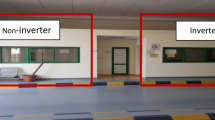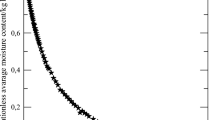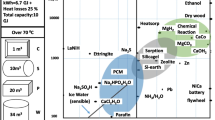Abstract
The heating requirements for district heating systems decrease sharply during the summer in China, which leads to the heating capacity of these systems remaining idle. To make full use of district heating systems, a novel approach for application of these thermal systems to cooling is proposed in this paper. The proposed system is based on a distributed absorption cooling (DAC) system driven by heat from the combined heat and power system. To investigate its energy-saving effects, the energy efficiency of the proposed DAC system was researched using the primary energy saving ratio (FESR) method. To assess the economic feasibility of the proposed system, the equivalent heating price for this DAC system was derived using economic analysis methods. The weight analysis method was used to analyse the factors affecting the energy efficiency of the DAC system. The research results showed that the energy efficiency and the economic feasibility of the proposed DAC system can be improved by increasing the heating-driven cooling efficiency. A new DAC system (IDAC) was then proposed based on integration of DAC with a heat-driven liquid desiccant dehumidifier (LDD), and the results show that the new system can increase the heating-driven cooling efficiency.












Similar content being viewed by others
References
Beijing Municipal Commission of Development and Reform. (2017a). Notifications about the reasonable adjustment of the electricity price structure; No. 1054.
Beijing Municipal Commission of Development and Reform. (2017b). Notice on adjusting the thermal power plant price of gas cogeneration plant in this municipality; No. 1797.
Eppelheimer, D. M. (1997). 97/03229 Variable flow—the quest for system energy efficiency[J]. Fuel and Energy Abstracts., 38, 4.
Fahlén, E., Trygg, L., & Ahlgren, E. O. (2012). Assessment of absorption cooling as a district heating system strategy–a case study. Energ Convers Manage., 60, 115–124.
Fumo, N., & Chamra, L. M. (2010). Analysis of combined cooling, heating, and power systems based on source primary energy consumption. Applied Energy, 87, 2023–2030.
General Administration of Quality Supervision, Inspection and Quarantine of People’s Republic of China. (2015). GB 19577–2015, Minimum allowable values of energy efficiency and energy efficiency grades for water chillers [S].
He, F., Xu, Y., Zhang, X., Liu, C., & Chen, H. (2015). Hybrid CCHP system combined with compressed air energy storage. International Journal of Energy Research, 39, 1807–1818.
Jiang, X. Z., Li, M., Zeng, G., & Shi, L. (2016). Multiple effects of energy storage units on combined cooling, heating and power (CCHP) systems. International Journal of Energy Research, 40, 853–862.
Kang, Y. Z., & Zuo, Z. (2009). Analysis of cooling capacity loss in the secondary pipe network of district cooling system. Heating Ventilating & Air Conditioning., 31–36.
Karlsson, V., & Nilsson, L. (2015). Co-production of pyrolysis oil and district cooling in biomass-based CHP plants: utilizing sequential vapour condensation heat as driving force in an absorption cooling machine. Applied Thermal Engineering, 79, 9–16.
Li, H., Fu, L., Geng, K., & Jiang, Y. (2006). Energy utilization evaluation of CCHP systems. Energy Buildings., 38, 253–257.
Ministry of Housing and Urban-Rural Development of the People’s Republic of China. (2015). GB 50189–2015, energy-saving design standards for public buildings[S].
Ondeck, A. D., Edgar, T. F., & Baldea, M. (2015). Optimal operation of a residential district-level combined photovoltaic/natural gas power and cooling system. Applied Energy, 156, 593–606.
Peng, Y. L., Walmsley, T. G., Alwi, S., Manan, Z. A., & Kleme, J. J. (2016). Integrating district cooling systems in locally integrated energy sectors through total site heat integration. Applied Energy, 184, 1350–1363.
Powell, K. M., Sriprasad, A., Cole, W. J., & Edgar, T. F. (2014). Heating, cooling, and electrical load forecasting for a large-scale district energy system. Energy., 74, 877–885.
Sameti, M., & Haghighat, F. (2017). Optimization approaches in district heating and cooling thermal network. Energy & Buildings, 140(APR.), 121–130.
Sameti, M., & Haghighat, F. (2018). Integration of distributed energy storage into net-zero energy district systems: optimum design and operation. Energy, 575–591.
Sameti, M., & Haghighat, F. (2019a). Hybrid solar and heat-driven district cooling system: optimal integration and control strategy. Solar Energy, 183, 260–275.
Sameti, M., & Haghighat, F. (2019b). Optimization of 4th generation distributed district heating system: design and planning of combined heat and power. Renewable Energy, 371–387.
Sun, L., Han, W., Jing, X., Zheng, D., & Jin, H. (2013). A power and cooling cogeneration system using mid/low-temperature heat source. Applied Energy, 112, 886–897.
Trygg, L., & Amiri, S. (2007). European perspective on absorption cooling in a combined heat and power system–a case study of energy utility and industries in Sweden. Applied Energy, 84, 1319–1337.
Tu, M., Ren, C., Zhang, L., & Shao, J. (2009). Simulation and analysis of a novel liquid desiccant air-conditioning system. Applied Thermal Engineering, 29, 2417–2425.
Wang, J. J., Jing, Y. Y., & Zhang, C. F. (2010). Optimization of capacity and operation for CCHP system by genetic algorithm. Applied Energy, 87, 1325–1335.
Xue, Z. F. (2007). Building energy efficiency technology and application[M]. Beijing: China Building Industry Press.
Zhang, X. (2016). “Total carbon efficiency” measure and regional eco-economic evaluation[M]. Beijing: China Environmental Science Press.
Zhu, Y. X., Wang, G., & JIANG, Y. (2008). Analysis of energy consumption of regional cooling system. Heating Ventilating & Air Conditioning., 36–40.
Funding
This research was supported by the project supported by the National Natural Science Foundation of China (51108017), the National Key R&D Program of China (Grant No. 2017YFC0704200).
Author information
Authors and Affiliations
Corresponding author
Ethics declarations
Conflict of interest
The authors declare that they have no conflict of interest.
Additional information
Publisher’s note
Springer Nature remains neutral with regard to jurisdictional claims in published maps and institutional affiliations.
Rights and permissions
About this article
Cite this article
Zhang, Q., Wang, Y., Zhang, X. et al. Techno-economic analysis of distributed absorption cooling system driven by a district heating system. Energy Efficiency 13, 1689–1703 (2020). https://doi.org/10.1007/s12053-020-09903-2
Received:
Accepted:
Published:
Issue Date:
DOI: https://doi.org/10.1007/s12053-020-09903-2




